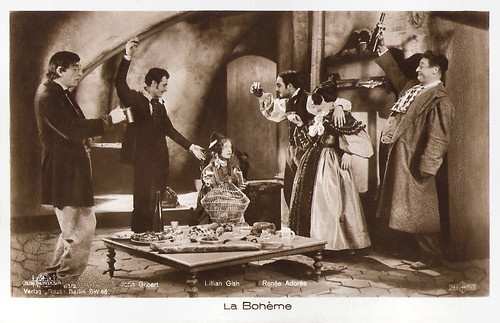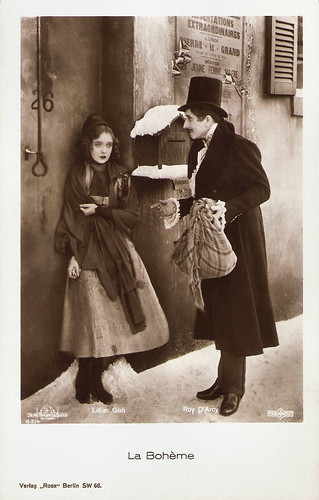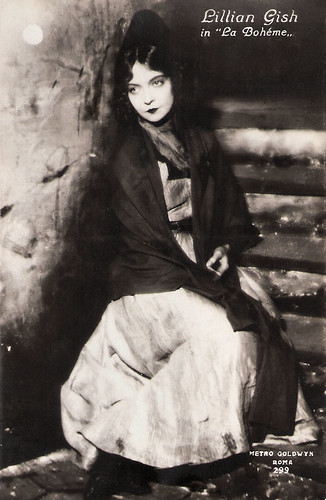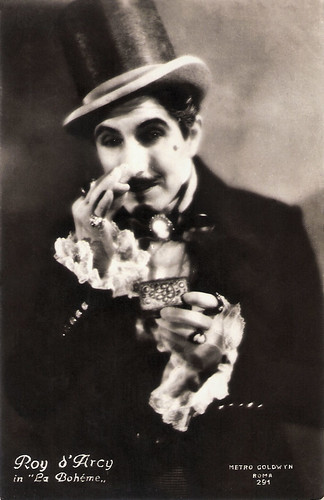In 1925, Lillian Gish moved to Metro-Goldwyn-Mayer after 13 years working with director David Wark Griffith on such classics as The Birth of a Nation (1915), Broken Blossoms (1919), and Orphans of the Storm (1921). Her first MGM picture was La Bohème (King Vidor, 1926). Director Vidor came fresh from his brilliant success with The Big Parade (1925) and took his two leading actors, John Gilbert and Renee Adoree, with him to La Bohème. The story about a group of starving artists in 19th century Paris was not based on Giacomo Puccini's opera but on Henri Murger's novel La Vie de Bohème (Life in the Latin Quarter, 1851). La Bohème (1926) is a classic romantic tragedy, which relates more to fantasy and mythology than to a realistic situation. It is an agonising, bittersweet fairytale.

Lillian Gish (or Renée Adorée?) and John Gilbert. German postcard by Ross Verlag, no. 63/1. Photo: Metro-Goldwyn-Mayer (MGM) / Parufamet. Publicity still for La Bohème (King Vidor, 1926).

Lillian Gish, John Gilbert and Renée Adorée. German postcard by Ross Verlag, no. 63/2. Photo: Metro-Goldwyn-Mayer (MGM) / Parufamet. Publicity still for La Bohème (King Vidor, 1926).

German postcard by Ross Verlag, no. 63/4. Photo: Metro-Goldwyn-Mayer (MGM) / Parufamet. Publicity still for La Bohème (King Vidor, 1926) with Lillian Gish and Roy D'Arcy.
The Quartier Latin of Paris, winter 1830. A group of carefree Bohemians try to survive, hoping to one day become famous. Rodolpho (John Gilbert) is a frustrated writer who lives and starves with his room mates, painter Marcel (Gino Corrado), musician Schaunard (George Hassell) and bookish Colline, played by a young Edward Everett Horton. The rent is due, but the money is not there. An article here, a painting there and a monkey with a cup gives them enough money for the rent, but not for food.
Fortunately, the saucy Musette (Renée Adorée) from downstairs has enough food for everyone including Mimi (Lillian Gish) - the frail and beautiful seamstress from next door. She has been given notice by the landlord, but Rodolpho and his friends rescue her and vow to always share their good fortune with her. Rodolphe and Mimi fall in love and Mimi works endlessly to support Rodolphe who is writing his play with a new found passion. But the rich, idle aristocrat Vicomte Paul (Roy D'Arcy) also has his lusting eye on Mimi and uses her embroidery to get close to her.
Rodolpho does not know that he has been discharged from writing for the magazine Dog and Cat Fanciers. Mimi wants to get his play produced and Vicomte Paul offers to help, but there is a terrible fight when Rodolphe thinks that Mimi is faithless to him with the count. After the fight, he seeks out a doctor as she is sick, but she has left when Rodolphe returns and will stay away until his play is finished.
Rodolphe searches for Mimi for months. Out of his anguish, a new and greater play is born. This turns out to be a hit, but he is miserable without Mimi. Meanwhile, Mimi is toiling in the slums of Paris, but the hard work is too much for the frail woman. She collapses. The doctor tells her coworkers that she will not live out the night. She stumbles out into the street and eventually reaches her old apartment. Rodolphe is ecstatic to see her. Their friends, however, realise her condition. While he goes to fetch her pet bird, she tells Musette she is happy, before dying.
Hal Erickson at AllMovie: "Though John Gilbert hams it up, Lillian Gish's brilliant performance is a model of restraint and subtlety. For her final scene, the actress went to appalling lengths to convincingly simulate death, going without water for three days and training herself to breathe without discernible movement (even when seen today, the effect is startlingly real)."
Steffi van Essen at IMDb: "Gilbert is not nearly as fine an actor as his leading lady, but he is again very much the right type for his part – an idealist with intelligent eyes and a warm smile. Other faces to look out for here are the very entertaining French actress Renée Adorée, and a rare glimpse of a silent-era Edward Everett Horton, although sadly before his comic talent was fully realised."

Lillian Gish. Italian postcard by Casa Editrice Ballerini & Fratini, Firenze (B.F.F.), no. 199. Photo: Metro Goldwyn, Roma (MGM). Publicity still for La Bohème (King Vidor, 1926).

Italian postcard by Casa Editrice Ballerini & Fratini, Firenze. Photo: Metro Goldwyn (MGM), Roma, no. 287. Publicity still for La Bohème (King Vidor, 1926). Although the postcard credits Lillian Gish, it's actually co-star Renée Adorée who is portrayed. (Thanks to Marlene Pilaete, for mentioning this).

Roy D'Arcy. Italian postcard by Casa Editrice Ballerini & Fratini, no. 291. Photo: Metro Goldwyn, Roma (MGM). Publicity still for La Bohème (King Vidor, 1926).
Sources: Hal Erickson (AllMovie), Steffi van Essen (IMDb), Wikipedia and IMDb.

Lillian Gish (or Renée Adorée?) and John Gilbert. German postcard by Ross Verlag, no. 63/1. Photo: Metro-Goldwyn-Mayer (MGM) / Parufamet. Publicity still for La Bohème (King Vidor, 1926).

Lillian Gish, John Gilbert and Renée Adorée. German postcard by Ross Verlag, no. 63/2. Photo: Metro-Goldwyn-Mayer (MGM) / Parufamet. Publicity still for La Bohème (King Vidor, 1926).

German postcard by Ross Verlag, no. 63/4. Photo: Metro-Goldwyn-Mayer (MGM) / Parufamet. Publicity still for La Bohème (King Vidor, 1926) with Lillian Gish and Roy D'Arcy.
The rent is due, but the money is not there
The Quartier Latin of Paris, winter 1830. A group of carefree Bohemians try to survive, hoping to one day become famous. Rodolpho (John Gilbert) is a frustrated writer who lives and starves with his room mates, painter Marcel (Gino Corrado), musician Schaunard (George Hassell) and bookish Colline, played by a young Edward Everett Horton. The rent is due, but the money is not there. An article here, a painting there and a monkey with a cup gives them enough money for the rent, but not for food.
Fortunately, the saucy Musette (Renée Adorée) from downstairs has enough food for everyone including Mimi (Lillian Gish) - the frail and beautiful seamstress from next door. She has been given notice by the landlord, but Rodolpho and his friends rescue her and vow to always share their good fortune with her. Rodolphe and Mimi fall in love and Mimi works endlessly to support Rodolphe who is writing his play with a new found passion. But the rich, idle aristocrat Vicomte Paul (Roy D'Arcy) also has his lusting eye on Mimi and uses her embroidery to get close to her.
Rodolpho does not know that he has been discharged from writing for the magazine Dog and Cat Fanciers. Mimi wants to get his play produced and Vicomte Paul offers to help, but there is a terrible fight when Rodolphe thinks that Mimi is faithless to him with the count. After the fight, he seeks out a doctor as she is sick, but she has left when Rodolphe returns and will stay away until his play is finished.
Rodolphe searches for Mimi for months. Out of his anguish, a new and greater play is born. This turns out to be a hit, but he is miserable without Mimi. Meanwhile, Mimi is toiling in the slums of Paris, but the hard work is too much for the frail woman. She collapses. The doctor tells her coworkers that she will not live out the night. She stumbles out into the street and eventually reaches her old apartment. Rodolphe is ecstatic to see her. Their friends, however, realise her condition. While he goes to fetch her pet bird, she tells Musette she is happy, before dying.
Hal Erickson at AllMovie: "Though John Gilbert hams it up, Lillian Gish's brilliant performance is a model of restraint and subtlety. For her final scene, the actress went to appalling lengths to convincingly simulate death, going without water for three days and training herself to breathe without discernible movement (even when seen today, the effect is startlingly real)."
Steffi van Essen at IMDb: "Gilbert is not nearly as fine an actor as his leading lady, but he is again very much the right type for his part – an idealist with intelligent eyes and a warm smile. Other faces to look out for here are the very entertaining French actress Renée Adorée, and a rare glimpse of a silent-era Edward Everett Horton, although sadly before his comic talent was fully realised."

Lillian Gish. Italian postcard by Casa Editrice Ballerini & Fratini, Firenze (B.F.F.), no. 199. Photo: Metro Goldwyn, Roma (MGM). Publicity still for La Bohème (King Vidor, 1926).

Italian postcard by Casa Editrice Ballerini & Fratini, Firenze. Photo: Metro Goldwyn (MGM), Roma, no. 287. Publicity still for La Bohème (King Vidor, 1926). Although the postcard credits Lillian Gish, it's actually co-star Renée Adorée who is portrayed. (Thanks to Marlene Pilaete, for mentioning this).

Roy D'Arcy. Italian postcard by Casa Editrice Ballerini & Fratini, no. 291. Photo: Metro Goldwyn, Roma (MGM). Publicity still for La Bohème (King Vidor, 1926).
Sources: Hal Erickson (AllMovie), Steffi van Essen (IMDb), Wikipedia and IMDb.
No comments:
Post a Comment